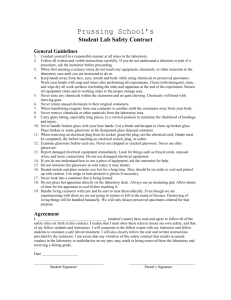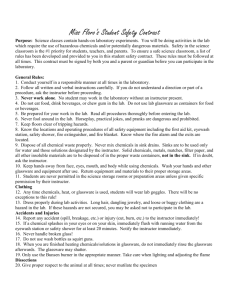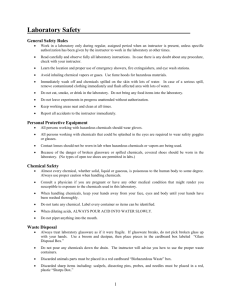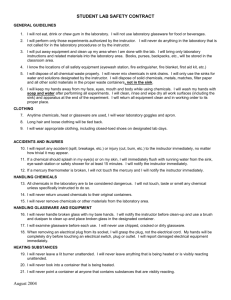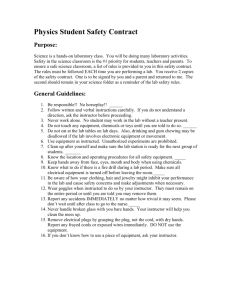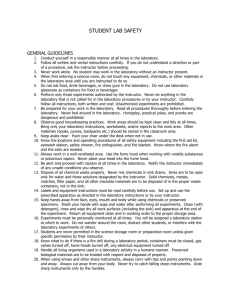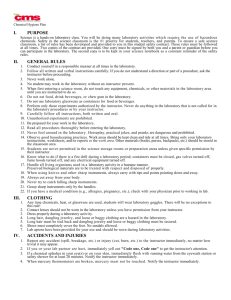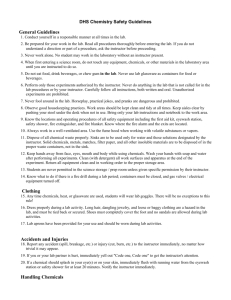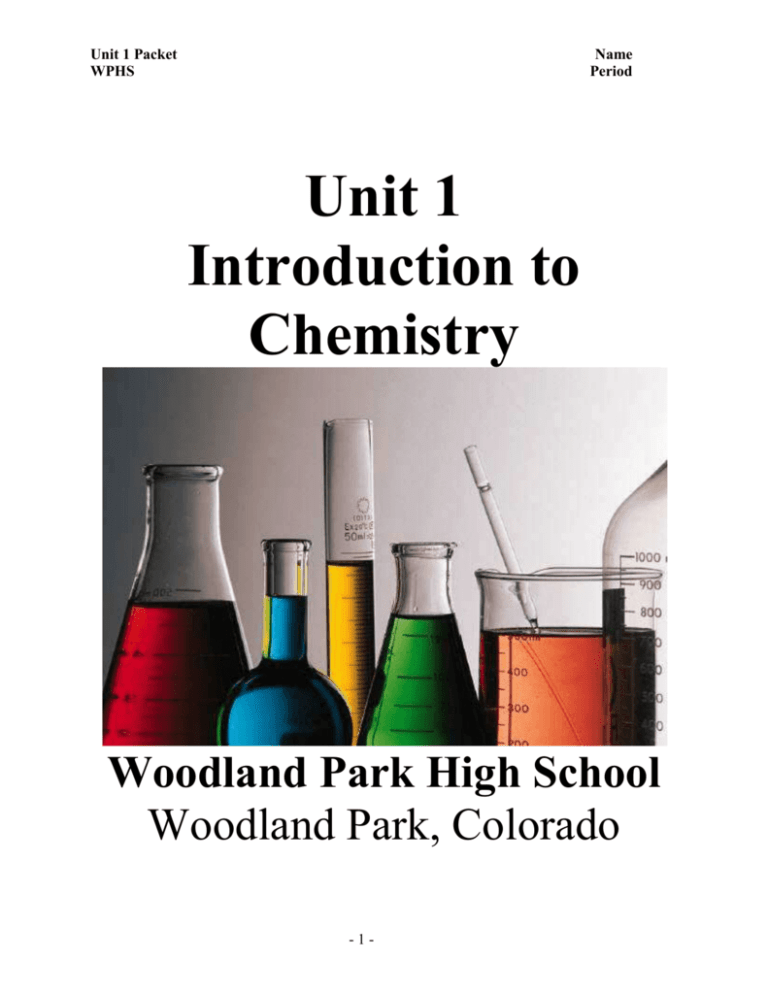
Unit 1 Packet
WPHS
Name
Period
Unit 1
Introduction to
Chemistry
Woodland Park High School
Woodland Park, Colorado
-1-
Unit 1 Packet
WPHS
Name
Period
Chemistry Unit 1 Check Off Sheet
Assignment
Can Only be
done in
Class
Podcast: Intro to Podcasting
Flinn Safety Contract
Purchase Composition Book & Lab Folder
Unit 1 Vocabulary Words
Podcast 1.1: Properties of Matter
Cool Demo
Worksheet 1.1: Properties of Matter
Podcast 1.2: Elements-Compounds-Mixtures
Worksheet 1.2: Elements-Compounds-Mixtures
THL 1.1 (A Mixture of Colors)
Podcast 1.3: Chemical and Physical Changes
Small Scale Lab 1 (A Study in Chemical Changes)
Worksheet 1.3: Chemical and Physical Changes
Baggie Demo
Podcast 1.4: Importance of Measurement
Safety Quiz
Worksheet 1.4: Importance of Measurement
Podcast 1.5: Precision & Counting Significant Figures
Worksheet 1.5: Precision & Counting Significant Figures
Podcast 1.6: Significant Figure Calculations
Worksheet 1.6: Significant Figure Calculations
Memory Quiz 1
THL 1.2 (“It Drives Me Crazy”)
Podcast 1.7: SI System-Density-Temperature
Worksheet 1.7: SI System-Density-Temperature
Memory Quiz 2
Lab: Density of Carbon Dioxide
Podcast 1.8: Dimensional Analysis (One Dimension)
Worksheet 1.8: Dimensional Analysis (One Dimension)
Podcast 1.9: Dimensional Analysis (Multiple Dimension)
Worksheet 1.9: Dimensional Analysis (Multiple Dimension)
Area of Idaho Problem
Lab Test (Density of a Block of Wood)
Unit 1 Exam (You must score 75/100 to move on)
-2-
X
X
X
x
X
X
X
X
X
√
Unit 1 Packet
WPHS
Name
Period
---------------------------------------------------------------------------------------------------------------------------------------------------------------------------------------------------------------------------------------------------------
-3-
Unit 1 Packet
WPHS
“Flinn Scientific’s
for Science Supplies”
PURPOSE
Science is a hands-on laboratory \
class. You will be doing many
laboratory activities which require
the use of hazardous chemicals.
Safety in the science classroom is
the #1 priority for students,
teachers, and parents. To ensure a
safe science classroom, a list of
rules has been developed and
provided to you in this student
safety contract. These rules must
be followed at all times. Two
copies of the contract are
provided. One copy must be
signed by both you and a parent
or guardian before you can
participate inthe laboratory. The
second copy is to be kept
in your science notebook as a
constant reminder of the safety
rules.
GENERAL RULES
1. Conduct yourself in a
responsible manner at all times in
the laboratory.
2. Follow all written and verbal
instructions carefully. If you do
not understand a direction or part
of a procedure, ask the instructor
before proceeding.
3. Never work alone. No student
may work in the laboratory
without an instructor present.
4. When first entering a science
room, do not touch any
equipment, chemicals, or
other materials in the laboratory
area until you are instructed to do
so.
5. Do not eat food, drink
beverages, or chew gum in the
laboratory. Do not use
laboratory glassware as containers
for food or beverages.
6. Perform only those experiments
authorized by the instructor.
Never do anything in the
laboratory that is not called
for in the laboratory procedures or
by your instructor. Carefully
follow all instructions, both
written and oral. Unauthorized
experiments are prohibited.
Name
Period
Student Safety Contracter Source
7. Be prepared for your work in
the laboratory. Read all
procedures thoroughly
before entering the laboratory.
8. Never fool around in the
laboratory. Horseplay, practical
jokes, and pranks are dangerous
and prohibited.
9. Observe good housekeeping
practices. Work areas should be
kept clean and tidy at all times.
Bring only your laboratory
instructions, worksheets, and/or
reports to the work area. Other
materials (books, purses,
backpacks, etc.) should be stored
in the classroom area.
10. Keep aisles clear. Push your
chair under the desk when not in
use.
11. Know the locations and
operating procedures of all safety
equipment including the first aid
kit, eyewash station, safety
shower, fire extinguisher, and fire
blanket. Know where the fire
alarm and the exits are located.
12. Always work in a wellventilated area. Use the fume
hood when working with
volatile substances or poisonous
vapors.
Never place your head into the
fume hood.
13. Be alert and proceed with
caution at all times in the
laboratory. Notify the instructor
immediately of any unsafe
conditions you observe.
14. Dispose of all chemical waste
properly. Never mix chemicals in
sink drains. Sinks are to be used
only for water and those solutions
designated by the instructor. Solid
chemicals, metals,
matches, filter paper, and all other
insoluble materials are to be
disposed of in the proper waste
containers, not in the sink. Check
the label of all waste containers
twice before adding your chemical
waste to the container.
15. Labels and equipment
instructions must be read carefully
before use. Set up and use the
prescribed apparatus as directed
-4-
in the laboratory instructions or by
your instructor.
16. Keep hands away from face,
eyes, mouth and body while using
chemicals or preserved specimens.
Wash your hands with soap and
water after performing all
experiments. Clean all work
surfaces and apparatus at the end
of the experiment. Return all
equipment clean and in working
order to the proper storage
area.
17. Experiments must be
personally monitored at all times.
You will be assigned a laboratory
station at which to work. Do
not wander around the room,
distract other students, or interfere
with the laboratory experiments of
others.
18. Students are never permitted
in the science storage rooms or
preparation areas unless given
specific permission by their
instructor.
19. Know what to do if there is a
fire drill
during a laboratory period;
containers must be closed, gas
valves turned off, fume hoods
turned off, and any electrical
equipment turned off.
20. Handle all living organisms
used in a laboratory activity in a
humane manner. Preserved
biological materials are to be
treated with respect and disposed
of properly.
21. When using knives and other
sharp instruments, always carry
with tips and
points pointing down and away.
Always cut away from your body.
Never try to catch falling sharp
instruments. Grasp sharp
instruments only by the handles.
22. If you have a medical
condition (e.g., allergies,
pregnancy, etc.), check with
your physician prior to working in
lab.
Unit 1 Packet
WPHS
CLOTHING
23. Any time chemicals, heat, or
glassware are used, students will
wear laboratory goggles. There
will be no exceptions to this rule!
24. Contact lenses should not be
worn in the laboratory unless you
have permission from your
instructor.
25. Dress properly during a
laboratory activity. Long hair,
dangling jewelry, and
loose or baggy clothing are a
hazard in the laboratory. Long
hair must be tied back and
dangling jewelry and loose or
baggy clothing must be secured.
Shoes must completely cover the
foot. No sandals allowed.
26. Lab aprons have been
provided for your
use and should be worn during
laboratory activities.
ACCIDENTS AND
INJURIES
27. Report any accident (spill,
breakage, etc.) or injury (cut,
burn, etc.) to the instructor
immediately, no matter how
trivial it may appear.
28. If you or your lab partner are
hurt, immediately yell out “Code
one, Code one” to get the
instructor’s attention.
29. If a chemical splashes in your
eye(s) or on your skin,
immediately flush with
running water from the eyewash
station or safety shower for at
least 20 minutes. Notify the
instructor immediately.
30. When mercury thermometers
are broken, mercury must not be
touched.
Notify the instructor immediately.
HANDLING
CHEMICALS
31. All chemicals in the laboratory
are to be considered dangerous.
Do not touch, taste, or smell any
chemicals unless specifically
instructed to do so. The
proper technique for smelling
chemical fumes will be
demonstrated to you.
32. Check the label on chemical
bottles twice before removing any
Name
Period
of the contents. Take only as
much chemical as you need.
33. Never return unused
chemicals to their original
containers.
34. Never use mouth suction to
fill a pipet. Use a rubber bulb or
pipet pump.
35. When transferring reagents
from one container to another,
hold the containers away from
your body.
36. Acids must be handled with
extreme care. You will be shown
the proper method for diluting
strong acids. Always
add acid to water, swirl or stir the
solution and be careful of the heat
produced, particularly with
sulfuric acid.
37. Handle flammable hazardous
liquids over a pan to contain
spills. Never dispense flammable
liquids anywhere near an open
flame or source of heat.
38. Never remove chemicals or
other materials from the
laboratory area.
39. Take great care when
transporting acids and other
chemicals from one part of the
laboratory to another. Hold them
securely and walk carefully.
HANDLING
GLASSWARE
AND EQUIPMENT
40. Carry glass tubing, especially
long pieces, in a vertical position
to minimize the likelihood of
breakage and injury.
41. Never handle broken glass
with your bare hands. Use a brush
and dustpan to clean up broken
glass. Place broken or
waste glassware in the designated
glass disposal container.
42. Inserting and removing glass
tubing
from rubber stoppers can be
dangerous. Always lubricate
glassware (tubing, thistle
tubes, thermometers, etc.) before
attempting to insert it in a stopper.
Always protect your hands with
towels or cotton gloves when
inserting glass
tubing into, or removing it from, a
rubber stopper. If a piece of
-5-
glassware becomes “frozen” in a
stopper, take it to your instructor
for removal.
43. Fill wash bottles only with
distilled water and use only as
intended, e.g., rinsing
glassware and equipment, or
adding water to a container.
44. When removing an electrical
plug from its socket, grasp the
plug, not the electrical
cord. Hands must be completely
dry before touching an electrical
switch, plug, or outlet.
45. Examine glassware before
each use. Never use chipped or
cracked glassware. Never use
dirty glassware.
46. Report damaged electrical
equipment immediately. Look for
things such as frayed cords,
exposed wires, and loose
connections. Do not use damaged
electrical equipment.
47. If you do not understand how
to use a piece of equipment, ask
the instructor for help.
48. Do not immerse hot glassware
in cold water; it may shatter.
HEATING
SUBSTANCES
49. Exercise extreme caution
when using a gas burner. Take
care that hair, clothing and hands
are a safe distance from the
flame at all times. Do not put any
substance into the flame unless
specifically instructed to do so.
Never reach over an exposed
flame. Light gas (or alcohol)
burners only as instructed by the
teacher.
50. Never leave a lit burner
unattended. Never leave anything
that is being heated or is visibly
reacting unattended. Always turn
the burner or hot plate off
when not in use.
51. You will be instructed in the
proper method of heating and
boiling liquids in
test tubes. Do not point the open
end of a test tube being heated at
yourself or anyone else.
52. Heated metals and glass
remain very hot for a long time.
They should be set aside to cool
and picked up with caution.
Unit 1 Packet
WPHS
Use tongs or heat-protective
gloves if necessary.
53. Never look into a container
that is being heated.
54. Do not place hot apparatus
directly on the laboratory desk.
Always use an insulating
pad. Allow plenty of time for hot
apparatus to cool before touching
it.
55. When bending glass, allow
time for the glass to cool before
further handling. Hot and cold
glass have the same visual
appearance. Determine if an
object is hot by bringing the back
of your hand close to it prior to
grasping it.
QUESTIONS
56. Do you wear contact lenses?
_ YES _ NO
57. Are you color blind?
_ YES _ NO
58. Do you have allergies?
_ YES _ NO
If so, list specific allergies
___________
___________________________
_____
___________________________
_____
AGREEMENT
I, _____________________ ,
(student’s name) have read and
agree to follow all of the safety
rules set forth in this contract. I
realize that I must obey these rules
to ensure my own safety, and that
Name
Period
of my fellow students and
instructors. I will cooperate
to the fullest extent with my
instructor and fellow students to
maintain a safe lab environment. I
will also closely follow the oral
and written instructions provided
by the instructor. I am aware
that any violation of this safety
contract that results in unsafe
conduct in the laboratory or
misbehavior on my part, may
result in being removed
from the laboratory, detention,
receiving a failing grade, and/or
dismissal from the course.
Student Signature
work. Please read the list of safety
rules above. No student will be
permitted to perform laboratory
activities unless this contract is
signed by both the student and
parent/guardian and is on file with
the teacher. Your signature on this
contract indicates that you have
read this Student Safety Contract,
are aware of the measures
taken to ensure the safety of
your son/daughter in the science
laboratory, and will instruct your
son/ daughter to uphold his/her
agreement to follow these rules
and procedures in the laboratory.
Parent/Guardian Signature
Date
Dear Parent or Guardian:
Date
We feel that you should be
informed regarding the school’s
effort to create and maintain a safe
science classroom/ laboratory
environment. With the
cooperation of the instructors,
parents, and students, a safety
instruction program can eliminate,
prevent, and correct possible
hazards. You should be aware of
the safety instructions your
son/daughter will receive before
engaging in any laboratory
-6-
© 2004, Flinn Scientific, Inc. All Rights Reserved.
Reproduction permission is granted to science
teachers who are customers of Flinn Scientific, Inc.
Batavia, Illinois, U.S.A. No part of this material may
be reproduced or transmitted
in any form or by any means, electronic or
mechanical, including, but not limited to photocopy,
recording, or any information storage and retrieval
system, without permission in writing from Flinn
Scientific, Inc.
Unit 1 Packet
WPHS
“Flinn Scientific’s
for Science Supplies”
PURPOSE
Science is a hands-on laboratory \
class. You will be doing many
laboratory activities which require
the use of hazardous chemicals.
Safety in the science classroom is
the #1 priority for students,
teachers, and parents. To ensure a
safe science classroom, a list of
rules has been developed and
provided to you in this student
safety contract. These rules must
be followed at all times. Two
copies of the contract are
provided. One copy must be
signed by both you and a parent
or guardian before you can
participate inthe laboratory. The
second copy is to be kept
in your science notebook as a
constant reminder of the safety
rules.
GENERAL RULES
1. Conduct yourself in a
responsible manner at all times in
the laboratory.
2. Follow all written and verbal
instructions carefully. If you do
not understand a direction or part
of a procedure, ask the instructor
before proceeding.
3. Never work alone. No student
may work in the laboratory
without an instructor present.
4. When first entering a science
room, do not touch any
equipment, chemicals, or
other materials in the laboratory
area until you are instructed to do
so.
5. Do not eat food, drink
beverages, or chew gum in the
laboratory. Do not use
laboratory glassware as containers
for food or beverages.
6. Perform only those experiments
authorized by the instructor.
Never do anything in the
laboratory that is not called
for in the laboratory procedures or
by your instructor. Carefully
follow all instructions, both
written and oral. Unauthorized
experiments are prohibited.
Name
Period
Student Safety Contract (Student Copy)ource
7. Be prepared for your work in
the laboratory. Read all
procedures thoroughly
before entering the laboratory.
8. Never fool around in the
laboratory. Horseplay, practical
jokes, and pranks are dangerous
and prohibited.
9. Observe good housekeeping
practices. Work areas should be
kept clean and tidy at all times.
Bring only your laboratory
instructions, worksheets, and/or
reports to the work area. Other
materials (books, purses,
backpacks, etc.) should be stored
in the classroom area.
10. Keep aisles clear. Push your
chair under the desk when not in
use.
11. Know the locations and
operating procedures of all safety
equipment including the first aid
kit, eyewash station, safety
shower, fire extinguisher, and fire
blanket. Know where the fire
alarm and the exits are located.
12. Always work in a wellventilated area. Use the fume
hood when working with
volatile substances or poisonous
vapors.
Never place your head into the
fume hood.
13. Be alert and proceed with
caution at all times in the
laboratory. Notify the instructor
immediately of any unsafe
conditions you observe.
14. Dispose of all chemical waste
properly. Never mix chemicals in
sink drains. Sinks are to be used
only for water and those solutions
designated by the instructor. Solid
chemicals, metals,
matches, filter paper, and all other
insoluble materials are to be
disposed of in the proper waste
containers, not in the sink. Check
the label of all waste containers
twice before adding your chemical
waste to the container.
15. Labels and equipment
instructions must be read carefully
before use. Set up and use the
prescribed apparatus as directed
-7-
in the laboratory instructions or by
your instructor.
16. Keep hands away from face,
eyes, mouth and body while using
chemicals or preserved specimens.
Wash your hands with soap and
water after performing all
experiments. Clean all work
surfaces and apparatus at the end
of the experiment. Return all
equipment clean and in working
order to the proper storage
area.
17. Experiments must be
personally monitored at all times.
You will be assigned a laboratory
station at which to work. Do
not wander around the room,
distract other students, or interfere
with the laboratory experiments of
others.
18. Students are never permitted
in the science storage rooms or
preparation areas unless given
specific permission by their
instructor.
19. Know what to do if there is a
fire drill
during a laboratory period;
containers must be closed, gas
valves turned off, fume hoods
turned off, and any electrical
equipment turned off.
20. Handle all living organisms
used in a laboratory activity in a
humane manner. Preserved
biological materials are to be
treated with respect and disposed
of properly.
21. When using knives and other
sharp instruments, always carry
with tips and
points pointing down and away.
Always cut away from your body.
Never try to catch falling sharp
instruments. Grasp sharp
instruments only by the handles.
22. If you have a medical
condition (e.g., allergies,
pregnancy, etc.), check with
your physician prior to working in
lab.
Unit 1 Packet
WPHS
CLOTHING
23. Any time chemicals, heat, or
glassware are used, students will
wear laboratory goggles. There
will be no exceptions to this rule!
24. Contact lenses should not be
worn in the laboratory unless you
have permission from your
instructor.
25. Dress properly during a
laboratory activity. Long hair,
dangling jewelry, and
loose or baggy clothing are a
hazard in the laboratory. Long
hair must be tied back and
dangling jewelry and loose or
baggy clothing must be secured.
Shoes must completely cover the
foot. No sandals allowed.
26. Lab aprons have been
provided for your
use and should be worn during
laboratory activities.
ACCIDENTS AND
INJURIES
27. Report any accident (spill,
breakage, etc.) or injury (cut,
burn, etc.) to the instructor
immediately, no matter how
trivial it may appear.
28. If you or your lab partner are
hurt, immediately yell out “Code
one, Code one” to get the
instructor’s attention.
29. If a chemical splashes in your
eye(s) or on your skin,
immediately flush with
running water from the eyewash
station or safety shower for at
least 20 minutes. Notify the
instructor immediately.
30. When mercury thermometers
are broken, mercury must not be
touched.
Notify the instructor immediately.
HANDLING
CHEMICALS
31. All chemicals in the laboratory
are to be considered dangerous.
Do not touch, taste, or smell any
chemicals unless specifically
instructed to do so. The
proper technique for smelling
chemical fumes will be
demonstrated to you.
32. Check the label on chemical
bottles twice before removing any
Name
Period
of the contents. Take only as
much chemical as you need.
33. Never return unused
chemicals to their original
containers.
34. Never use mouth suction to
fill a pipet. Use a rubber bulb or
pipet pump.
35. When transferring reagents
from one container to another,
hold the containers away from
your body.
36. Acids must be handled with
extreme care. You will be shown
the proper method for diluting
strong acids. Always
add acid to water, swirl or stir the
solution and be careful of the heat
produced, particularly with
sulfuric acid.
37. Handle flammable hazardous
liquids over a pan to contain
spills. Never dispense flammable
liquids anywhere near an open
flame or source of heat.
38. Never remove chemicals or
other materials from the
laboratory area.
39. Take great care when
transporting acids and other
chemicals from one part of the
laboratory to another. Hold them
securely and walk carefully.
HANDLING
GLASSWARE
AND EQUIPMENT
40. Carry glass tubing, especially
long pieces, in a vertical position
to minimize the likelihood of
breakage and injury.
41. Never handle broken glass
with your bare hands. Use a brush
and dustpan to clean up broken
glass. Place broken or
waste glassware in the designated
glass disposal container.
42. Inserting and removing glass
tubing
from rubber stoppers can be
dangerous. Always lubricate
glassware (tubing, thistle
tubes, thermometers, etc.) before
attempting to insert it in a stopper.
Always protect your hands with
towels or cotton gloves when
inserting glass
tubing into, or removing it from, a
rubber stopper. If a piece of
-8-
glassware becomes “frozen” in a
stopper, take it to your instructor
for removal.
43. Fill wash bottles only with
distilled water and use only as
intended, e.g., rinsing
glassware and equipment, or
adding water to a container.
44. When removing an electrical
plug from its socket, grasp the
plug, not the electrical
cord. Hands must be completely
dry before touching an electrical
switch, plug, or outlet.
45. Examine glassware before
each use. Never use chipped or
cracked glassware. Never use
dirty glassware.
46. Report damaged electrical
equipment immediately. Look for
things such as frayed cords,
exposed wires, and loose
connections. Do not use damaged
electrical equipment.
47. If you do not understand how
to use a piece of equipment, ask
the instructor for help.
48. Do not immerse hot glassware
in cold water; it may shatter.
HEATING
SUBSTANCES
49. Exercise extreme caution
when using a gas burner. Take
care that hair, clothing and hands
are a safe distance from the
flame at all times. Do not put any
substance into the flame unless
specifically instructed to do so.
Never reach over an exposed
flame. Light gas (or alcohol)
burners only as instructed by the
teacher.
50. Never leave a lit burner
unattended. Never leave anything
that is being heated or is visibly
reacting unattended. Always turn
the burner or hot plate off
when not in use.
51. You will be instructed in the
proper method of heating and
boiling liquids in
test tubes. Do not point the open
end of a test tube being heated at
yourself or anyone else.
52. Heated metals and glass
remain very hot for a long time.
They should be set aside to cool
and picked up with caution.
Unit 1 Packet
WPHS
Use tongs or heat-protective
gloves if necessary.
53. Never look into a container
that is being heated.
54. Do not place hot apparatus
directly on the laboratory desk.
Always use an insulating
pad. Allow plenty of time for hot
apparatus to cool before touching
it.
55. When bending glass, allow
time for the glass to cool before
further handling. Hot and cold
glass have the same visual
appearance. Determine if an
object is hot by bringing the back
of your hand close to it prior to
grasping it.
QUESTIONS
56. Do you wear contact lenses?
_ YES _ NO
57. Are you color blind?
_ YES _ NO
58. Do you have allergies?
_ YES _ NO
If so, list specific allergies
___________
___________________________
_____
___________________________
_____
AGREEMENT
I, _____________________ ,
(student’s name) have read and
agree to follow all of the safety
rules set forth in this contract. I
realize that I must obey these rules
to ensure my own safety, and that
Name
Period
of my fellow students and
instructors. I will cooperate
to the fullest extent with my
instructor and fellow students to
maintain a safe lab environment. I
will also closely follow the oral
and written instructions provided
by the instructor. I am aware
that any violation of this safety
contract that results in unsafe
conduct in the laboratory or
misbehavior on my part, may
result in being removed
from the laboratory, detention,
receiving a failing grade, and/or
dismissal from the course.
Student Signature
work. Please read the list of safety
rules above. No student will be
permitted to perform laboratory
activities unless this contract is
signed by both the student and
parent/guardian and is on file with
the teacher. Your signature on this
contract indicates that you have
read this Student Safety Contract,
are aware of the measures
taken to ensure the safety of
your son/daughter in the science
laboratory, and will instruct your
son/ daughter to uphold his/her
agreement to follow these rules
and procedures in the laboratory.
Parent/Guardian Signature
Date
Dear Parent or Guardian:
Date
We feel that you should be
informed regarding the school’s
effort to create and maintain a safe
science classroom/ laboratory
environment. With the
cooperation of the instructors,
parents, and students, a safety
instruction program can eliminate,
prevent, and correct possible
hazards. You should be aware of
the safety instructions your
son/daughter will receive before
engaging in any laboratory
-9-
© 2004, Flinn Scientific, Inc. All Rights Reserved.
Reproduction permission is granted to science
teachers who are customers of Flinn Scientific, Inc.
Batavia, Illinois, U.S.A. No part of this material may
be reproduced or transmitted
in any form or by any means, electronic or
mechanical, including, but not limited to photocopy,
recording, or any information storage and retrieval
system, without permission in writing from Flinn
Scientific, Inc.
Unit 1 Packet
WPHS
Name
Period
Chemistry
Class Requirements
J. Bergmann & A. Sams
I. General class requirements:
Welcome to Woodland Park Chemistry. We are excited to have you in class this year. We promise that you will be challenged, that you will be
engaged, and that you will even have some fun.
II. Grading:
Grading will be done via a “mastery” system. This will be explained in detail at the beginning of the class.,
III.
Make up and late work:
This is somewhat obsolete since Chemistry is a self-paced course. But Mr. Sams and Mr. Bergmann want to emphasize that you work toward
each of the dates that will be posted in the class.
IV. Scholarly etiquette: It is very important that students learn the proper means and methods to interact with adults and peers in scholastic and
business setting. To this aim, I would like to maintain a friendly and business-like class atmosphere by asking that students adhere to the
following:
Please raise your hand to be recognized before speaking. Interrupting the instructor or other classmates is not acceptable
behavior.
When class time is given to students to work on assignments, please do not waste that time by unnecessary socializing.
Always be courteous to other classmates and the instructor.
V. Materials:
Since chemistry is a rigorous class, it is essential that you are organized.
Required supplies:
Pen and pencil (daily)
Graphing or scientific calculator (daily) (TI 80 something)
Flash Drive
Textbook
Lab folder (colored)
Composition Notebook for notes
VI. Class organization
Chapter syllabi will be provided with the daily schedule, homework, and assignments due arranged by day.
VII. Extra help:
Chemistry is a difficult, but manageable, class. Thus, we don't expect students to understand everything right away. We are available for help
outside of class. If you have questions about course materials (and you would be strange if you didn't), your grade, or you would just like to talk
about life, we encourage you to drop by our office. Please feel free to visit either instructor, we communicate constantly about the course and are
more than willing to help each other’s students.
Jon Bergmann
Aaron Sams
Room 313
Room 314
jbergmann@wpsdk12.org
asams@wpsdk12.org
Before and after school, by appointment
Before and after school, by appointment
- 10 -
Unit 1 Packet
WPHS
Name
Period
Unit 1 Vocabulary: Put this in the first few pages of your Notes-Composition Book
Matter
Mass
Substance
physical property
intensive property
extensive property
solid
liquid
gas
vapor
Heterogeneous Mixture
Homogeneous Mixture
Solutions
Element
Compound
qualitative measurements
quantitative measurements
Scientific notation.
Accuracy
Precision
accepted value
experimental value
error
percent error.
significant figures
International System of Units (SI)
Density
Temperature
Celsius scale
Kelvin scale
absolute zero.
- 11 -
Unit 1 Packet
WPHS
Name
Period
Take Home Lab
Parent/Student Experiment
Name_____________________
Date__________Period______
A Mixture of Colors
Subject/Concept: Chemistry - Chromatography, Mixtures and Compounds
Purpose: The purpose of this activity is to determine whether the colors of marker dyes and/or
food coloring are due to a single compound or a mixture of several other colors.
Materials:
paper towel strips (1.5” wide and as long as your glasses are tall)
at least 4 clear, tall glasses
at least 4 different colors of water-based markers (if you can, be sure to try black, brown,
orange, and/or green)
4 different colors of food coloring (Schilling™ or Crown Colony™ brands work well)
at least 4 pencils or pens
you may choose 1 option or both options
Procedure:
1. For each glass, cut one long strip out of a paper towel, 1.5” wide and as long as your
glasses are tall.
2. One inch from the bottom of the paper towel strip, make a heavy line with the marker you
wish to test. If you are testing food coloring, place one drop of the food coloring one
inch from the bottom of the strip.
3. Put one inch of lukewarm tap water in one of the glasses. Dangle the bottom half-inch of
the paper towel strip below the marker line or food coloring spot into the water in the
glass and secure by poking a pencil through the top of the paper towel, level with the rim
of the glass. Do not let the paper towel strip touch the side of the glass.
4. For the next hour, make periodic observations of the absorption pattern of water and
dye(s) up the paper towel.
5. Do this for at least four different colors of markers or food coloring. Record any
observations.
1.
Clean up your mess!
pencil
water
wat er
Marker Set-up
Food Coloring Set-up
- 12 -
Unit 1 Packet
WPHS
Name
Period
Questions:
1. Which colors are composed of a mixture of other colors?
2. Which colors are composed of only a single substance?
3. How could a test like this be used to determine the purity of a chemical such as a drug or
food additive?
For Credit:
To receive credit, your parent or guardian must write a short note confirming that you
performed the experiment for them and explained the results to their satisfaction using the
concept of chromatography, and mixtures and compounds. Attach your note to the back of
this sheet.
- 13 -
Unit 1 Packet
WPHS
Name
Period
Parent/Student Experiment: Title: Error - It Drives Me Crazy!
Subject/Concept: Physics - Percent Error
Purpose: The purpose of this activity is to approximate the percent error in the speed
measurements made by the speedometer of the family car.
Materials:
• family car
• working odometer
• small green mileage signs located on major highways
Procedure:
Safety Note: In order to receive credit, the automobile used in this experiment must be
driven in a manner consistent with all legal and reasonable requirements and also must be
driven by the parent or legal guardian. This does require driving on the highway and
should not be attempted unless the driver is comfortable and practiced in doing so.
1. On the highway, record to the nearest half of one-tenth of a mile the distance covered by
your car for exactly 3.0 miles as measured by the small green signs located along the side
of the highway. If your car is like most cars on the road, your odometer will not read
exactly the 3.00 miles for the test segment, but perhaps 2.85 or up to 3.15 miles.
2. Calculate the percent error of the car’s odometer. Since your odometer and speedometer
are connected, this will also be the percent error of your speedometer.
Questions:
1. What was your cars odometer reading for the 3.0 miles covered between green signs?
2. What is the percent error in your odometer? (Show your calculation)
3. What speed are you actually traveling at when your speedometer reads 55 mph?
For Credit:
To receive credit, complete the questions for this lab on a separate piece of paper. Also,
your parent or guardian must write a short note confirming that you performed the experiment
for them and explained the results to their satisfaction using the concept of percent error.
Attach your note to the back of this sheet.
- 14 -
Unit 1 Packet
WPHS
Name
Period
Small Scale Lab 1: A Study of Chemical Changes
Name ____________
Objectives:
Observe and record chemical changes involving chemicals found in common consumer
products.
Design and carry out experiments to identify chemicals in consumer products
Demonstrate the use of the names and formulas of common chemical compounds.
Introduction
Chemistry is a science that investigates changes in matter. Chemical reactions are the chages
matter undergoes. The changes you can observe are called “macroscopic” changes. Often these
changes, such as color changes, the formation of a solid, or the formation of gas bubbles, are
visible. Thus, though we can not see the atoms and molecules reacting, we can see indications
that chemical changes have taken place.
Different atoms and molecules often react in different ways. Chemistry attempts to explain
macroscopic changes in terms of the behavior of atoms and molecules, that is, on the
submicroscopic level. You can use these different reactions to detect the presences of specific
kinds of chemicals in mixtures.
Purpose
In this lab you will study some reactions of common chemicals contained in consumer products.
You will observe the notable microscopic changes in terms of submicroscopic changes, the
behavior of atoms and molecules. As the name implies, submicroscopic changes are changes we
cannot see, even with a microscope. The essence of understanding chemistry is to infer from
macroscopic changes the submicroscopic behavior of atoms and molecules.
Safety
Wear your safety glasses
Use full small-scale pipets only for the carefully controlled delivery of liquids
Materials
Sodium Hydrogen
Carbonate (NaHCO3)
Sodium Carbonate
(Na2CO3)
Sodium Hypochlorite
(NaOCl)
Silver Nitrate (AgNO3)
Blue Dye
Potassium Iodide (KI)
Sodium Hydroxide
(NaOH)
Lead II nitrate
(Pb(NO3)2
Copper II Sulfate
(CuSO4)
Ammonia (NH3)
Sodium hydrogen
Sulfate (NaHSO4)
Starch
- 15 -
Calcium Chloride
(CaCl2)
Hydrochloric acid (HCl)
Phenolphthalein
(PHEN)
Unit 1 Packet
WPHS
Name
Period
Experimental Page
Use small-scale pipets to put 2 drops of each chemical on the X’s in the indicated spaces below.
For background contrast, view the drops on black and white backgrounds provided by the X’s.
Stir each mixture by blowing air through an empty pipet. Record what you see in table 1.1
a.
NaHCO3
h.
NaHSO4
+
+
HCl
Na2CO3
b.
c.
d.
e.
f.
g.
X
X
X
X
X
X
X
HCl
+
Blue Dye
i.
Blue Dye
+ NaOCl
Now add 1 drop
HCl
j.
NaOCl
+
KI
Now add 1 drop
starch
KI
+
Pb(NO3)2)
k.
Pb(NO3)2
+
CaCl2
m.
CaCl2
+
NaHSO4
Be patient
N
l.
- 16 -
X
X
X
X
X
X
X
Na2CO3
+
PHEN
PHEN
+
NaOH
NaOH
+
AgNO3
AgNO3 + NH3
Absorb onto scrap of paper
and expose to sunlight:
Tape to your data table
NH3
+
CuSO4
CuSO4
+
NaHCO3
Unit 1 Packet
WPHS
Experimental Data
a.
Name
Period
NaHCO3
+
HCl
h.
NaHSO4
+
Na2CO3
b.
HCl
+
Blue Dye
i.
Na2CO3
+
PHEN
c.
Blue Dye
+ NaOCl
Now add 1 drop
HCl
j.
PHEN
+
NaOH
d.
NaOCl
+
KI
Now add 1 drop
starch
KI
+
Pb(NO3)2)
k.
NaOH
+
AgNO3
l.
AgNO3 + NH3
f.
Pb(NO3)2
+
CaCl2
m.
NH3
+
CuSO4
g.
CaCl2
+
NaHSO4
Be patient
N
CuSO4
+
NaHCO3
e.
Absorb onto scrap of paper
and expose to sunlight:
Tape to your data table
- 17 -
Unit 1 Packet
WPHS
Name
Period
Questions
1. Sodium hydrogen carbonate is baking soda, NaHCO3. When HCl is added to NaHCO3,
carbon dioxide bubbles are formed. Do you know the chemical formula of carbon
dioxide? In what consumer product is the gas commonly found?
2. Which of the other mixings formed bubbles?
3. What do you think the gas is that results from question 2?
4. The body uses hydrochloric acid, HCl, to help digest food. Where in the body is
hydrochloric acid found? What color does it turn the blue food dye?
5. Sodium hypochlorite, NaOCl, is a common ingredient in household bleaches and
cleaners. What happened to the color of the the blue dye when both HCl and NaOCl was
added?
6. Potassium Iodide, KI, is the source of iodine in iodized salt. What color is the KI +
NaOCl mixture? What color does starch change to in the presence of KI and NaOCl?
7. A precipitate is a solid that separates upon mixing solutions. Which reaction made a
bright yellow precipitate?
8. Which other mixings produced precipitates?
9. Which mixture produced a precipitate very slowly?
10. Which solutions produced a muddy brown precipitate?
11. Observe the scrap paper you used to absorb the AgNO3 + NH3 mixture. What evidence
do you see that indicates that silver compounds are light sensitive?
12. Review your results and list at least three different kinds of changes that indicate that a
chemical reaction is occurring.
- 18 -
Unit 1 Packet
WPHS
Name
Period
Density of Carbon Dioxide Lab
Background Information
Alka Seltzer is a mixture of baking soda and citric acid. When these substances come into contact in
water they react to produce carbon dioxide gas, water and sodium citrate.
NaHCO3 +
H3C6H5O7
H2O
+
CO2
+
NaH2C6H5O7
Baking
Citric
Water
Carbon
Sodium
soda
acid
dioxide
citrate
Purpose
To calculate the density of carbon dioxide
Procedure
1. Obtain one Alka Seltzer tablet and break
roughly equal sized pieces
2. Place 10 mL of water into a flask
3. Find the mass of the flask with the water
4. Weigh the ¼ piece of tablet (dry)
5. Fill a graduated cylinder completely with
invert into a tub of room temperature
6. Place the tube from the flask into the upgraduated cylinder
7. Drop the tablet into the water and
immediately stopper the flask
8. Collect the gas in the graduated cylinder
9. Measure the volume of gas collected
10. Measure the mass of the flask and the
the reaction is complete
11. Complete procedure two more times for a total of three trials
Data
Trial 1
Trial 2
Mass of ¼ tablet (g)
Mass of flask and water
(g)
Total beginning mass of
tablet, flask and water (g)
Mass of tablet, flask and
water after reaction (g)
Mass of CO2 (g)
Volume of CO2 collected
(mL)
Volume of CO2 collected
(L)
Density of CO2 (g/L)
Average density of 3 trials
- 19 -
it into four
water and
water
turned
tablet after
Trial 3
Unit 1 Packet
WPHS
Name
Period
Calculations
Use this space to show calculations for total beginning mass, mass of CO2, conversion from mL of CO2 to
L CO2, density of CO2 and average density
Total beginning mass
Mass of CO2
Conversion from mL of CO2 to L CO2
Density of CO2
Average density
Questions
1. You just collected a gas by water displacement. Describe the process in detail so someone not in
this class could understand what water displacement is.
2. Show and describe how the mass of the gas was calculated?
3. What is density? Why is it useful to scientists?
- 20 -
Unit 1 Packet
WPHS
Name
Period
Worksheet 1.1: Properties of Matter
1.
Identify the following as an extensive or an intensive property
Property
Mass
volume
density
color
Viscosity (how “thick” a liquid is)
2.
Extensive or Intensive
Identify the following about solids-liquids-gases (definite or indefinite)
Solid
Liquid
Gas
Volume
Shape
3.
Draw a picture at the molecular level of a solid, a liquid and a gas.
- 21 -
Unit 1 Packet
WPHS
Name
Period
Worksheet 1.2: Elements-Compounds-Mixtures
Classification of Matter
How do atoms combine to make different types of matter?
Why?
Look at the things in this room. They are all matter. That matter may be pure or it may be a mixture.
Can you tell by looking at it? What if you looked at it under a microscope? Then could you tell?
Something that looks pure may not really be pure. It depends on what type of particles that thing is
made of. In this activity we will explore how the smallest chemical units of matter determine
whether something is classified as an element, a compound, or a mixture.
Model 1
R
T & RSq &
?
R
atom
8 particles
?
R
molecule
Sq2
S
q
molecule
?
atoms
5 particles
TSq2R
- 22 -
molecule
SqR3 & TSq
Unit 1 Packet
WPHS
Name
Period
5 particles
1. Circle a molecule of RSq in Model 1. How many atoms are in a molecule of RSq?
2. Circle a molecule of TSq2R in Model 1.
a) How many different types of atoms are found in a molecule of TSq2R?
b) How many Sq atoms are in a molecule of TSq2R?
3. a) How many different types of atoms are found in a sample of SqR3 & TSq?
b) How many different types of molecules are found in a sample of SqR3 & TSq?
4. a) What does it mean when two atoms are touching in the drawings of Model 1?
b) What does it mean when two atoms or molecules are not touching in the drawings of Model 1?
5. a) Can a particle be a single atom?
b) Can a particle be a molecule?
c) How many particles are in the drawing representing T & RSq & R in Model 1?
6. Compare the codes listed at the top of each drawing in Model 1 with the shapes in that box.
a) What do the letters R, Sq and T in the codes represent?
b) What do the small numbers (subscripts) in the codes represent?
c) When atoms are touching, how is that communicated in the code?
d) When atoms or molecules are not touching, how is that communicated in the code?
e) In Model 1 there are three drawings that are labeled “?”. Write codes to properly label
these drawings.
- 23 -
Unit 1 Packet
WPHS
Name
Period
7. The manager should appoint one group member to cut apart Model 1 to separate the nine
drawings. As a team, sort the pictures into those where all the particles in the drawing are identical,
and those that have more than one type of particle in the drawing.
Read This!
Matter is classified as a pure substance when all of the particles are the identical. Matter is classified
as a mixture if there are different particles present.
8. Identify which set of drawings from #7 are pure substances and which set are mixtures. List the
codes for each set here.
Pure Substances
____________
____________
Mixtures
____________
____________
____________
____________
____________
____________
____________
9. How are the codes (chemical formulas) for pure substances different from those for mixtures?
10. As a team, take the set of pure substances drawings from #8 and sort them into those containing
only one type of atom and those with two or more types of atoms.
Read This!
Elements are defined as substances made from only one type of atom. Compounds are defined as
substances made from two or more types of atoms.
11. Identify which set of drawings from #10 are elements and which set are compounds. List the
codes for each set here.
Elements
____________
Compounds
____________
____________
____________
____________
____________
12. How are the codes (chemical formulas) for elements different from those for compounds?
- 24 -
Unit 1 Packet
WPHS
Name
Period
13. Use what you have just learned about chemical formulas to identify the following as element, compound or mixture.
a. Br2
b. NaHCO3
d. Cu & Zn
c. C6H12O6 & H2O
e. CO2
f. Al
Extension Questions
14. Often times it is useful to separate matter. For example, you strain cooked pasta to get the liquid out. In a fuel cell, water is separated into
hydrogen and oxygen.
a) Which type of matter can be separated by physical methods (no bonds need to break) such
as filtering or distillation?
b) Which type of matter needs to be separated by chemical methods (breaking of bonds
required) such as electrolysis or decomposition?
15. Students in a chemistry course were asked the following question on a unit exam:
“Draw a diagram representing an element using circles as atoms.”
a) The following diagrams represent the two types of answers given by students. Which drawing
is the best representation of an element? Explain.
Drawing A
Drawing B
b) If Drawing B was a sample from the substances in Model 1, which substance(s) could be
represented? Is a single atom a good representation of any of them?
- 25 -
Unit 1 Packet
WPHS
Name
Period
1.
Classify each as a homogeneous or heterogeneous mixture: Put a check in the appropriate box
Homogeneous Heterogeneous
blood
chocolate chip ice cream
brass (a blend of copper and zinc)
motor oil
Black Coffee
2.
Classify each as an element or a mixture: Put a check in the appropriate box
Element
Mixture
Silver
Pine Tree
Orange Juice
Oxygen
Iced Tea
Air
3.
List the names of elements in each of the following compounds.
Elements (Example, Nitrogen, Chromium, et)
Ammonium Chloride (NH4Cl)
Potassium Permanganate (KMnO4)
Isopropyl Alcohol (C3H7OH)
Calcium Iodide (CaI2)
4.
Identify each of the following as a mixture or a compound. For the mixtures, classify each as
homogeneous or heterogeneous.
Mixture or
If a mixture:
Justify your answer
Compound Homogeneous or
Heterogeneous
Soda
Sucrose (table sugar)
motor oil (a mixture of hydrocarbons)
Black Ink
Ice
Gasoline
Granite
Muddy Water
Tossed Salad
Candle Wax
Sodium chloride
Carbon dioxide
Worksheet 1.3: Chemical and Physical Changes
1. List the four indicators of a chemical change.
a.
b.
c.
- 26 -
Unit 1 Packet
WPHS
Name
Period
d.
2. Classify each of the following as a physical or chemical change.
Physical
Chemical
Bending a piece of wire.
Burning coal
Cooking a steak
Cutting grass
Vinegar and baking soda mixing.
3. How do you know that each of these is a chemical change
Reason
Food spoils
A foaming antacid tablet
fizzes in water.
A ring of scum forms
around your bathtub.
A firecracker explodes
Worksheet 1.4: The Importance of Measurement
1.
Identify the following as quantitative or qualitative.
Qualitative or quantitative
A flame is hot
A candle has a mass of 90 g
Wax is soft
A candle’s height decreases 4.2 cm/hr
2.
Write the following numbers in scientific notation
In Scientific Notation
720000000 meters
0.000000065 grams
54300 L
0.015 moles
3.
Write the following numbers in regular notation.
In Regular Notation
15
6.02 10 mL
3.02 10-6 mg
3.00 10-7 M
2.98 108 m/s
4.
Rank each of the following in order from smallest to largest.
2.2x 104
27 x 103
2.9 x 10-2
Worksheet 1.5: Precision - Sig. Figs
- 27 -
0.0027
2.1 x 10-3
Unit 1 Packet
WPHS
1.
Name
Period
Three students made multiple weightings of a copper rod, each using a different balance. The correct mass
of the cylinder had been previously determined to be 47.32g. Describe the accuracy and precision of each
student’s measurements.
Marie
Albert
Ernest
Weigh 1
47.13
47.45
47.95
Weigh 2
47.94
47.39
47.91
Weigh 3
46.83
47.42
47.89
Weigh 4
47.47
47.41
47.93
Marie:
Albert:
Ernest:
2. Three scientists measure the standard meter bar kept at the International Bureau of
Standards. Their measurements are 1.09 m, 1.09 m, and 1.08 m. Are their measurements
accurate, precise, or both? Why?
3. An archer shoots three arrows at a target and each lands within 1 cm of the others but
none of the arrows is within 30 cm of the bull's-eye. Discuss both the accuracy and the
precision of the archer.
4. Determine the number of significant figures in each of the following measurements:
a. 1.0 cm
b. 3.05 cm
c. 2500 cm
d. 4050 cm
e. 4.050 cm
f. 0.0602 cm
5. Why would a measurement be reported as 18.0 mL instead of 18 mL?
- 28 -
Unit 1 Packet
WPHS
Name
Period
Worksheet 1.6 Significant Figure Calculations
Perform the following calculations and report each answer to the correct number of significant
figures:
Addition and Subtraction Problems
Calculator Answer
Rounded to the correct number
of significant figures
162.1 g + 38.73 g + 1.554 g
21.9 m + 6.34 m + 157 m
0.004 dm + 0.12508 dm
0.025 mol + 0.0267 mol + 0.00287 mol
9.88 s - 7.2 s
44.7 kg - 2.7 kg
20 L - 20.0 L
3.00 g- 2.89 g
9.23 mL – 8.8943 mL
Multiplication and Division Problems
Calculator Answer
6.5 cm x 2.1 cm
2.33 m x 5.15 m
12.65m x 42.1 m
3.02 cm x 6.3 cm x 8.225 cm
40.1 kg x 0.2453 m2
340m / 0.1257 s
1.29 g / 29.20 cm3
3.244 m / 1.4 s
62 g / 1.62 cm3
45.4 g / (0.012 cm x 0.444 cm x 0.221 cm)
( 3 x 105 m) (2 x 107m)
(4.2 x 107kg)( 3.09 x 10-2m)
(5.21 x 10-5nm)/(3.623 x 104 s)
(2.05 x 10-2 mol)/ (2.03 x 10-1L)
- 29 -
Rounded to the correct number of
significant figures: don’t forget the
units
Worksheet 1.7: SI-Density-Temperature
1. List the dimensions for the following measurements:
Measurement
Dimension (length, mass, time, temperature, etc): Note that some may
have multiple dimensions-for those list all dimensions)
55m
4.3 10-2 sec
43.2 mol
0.0021 µm
2.0 L
32.0 gal
161 lb
1 light year
43 Kelvin
6000 lumens
12.5 m2
16 miles per hour
0.0032 kg m/sec2
235 g/mol
2. Convert the following temperatures:
Measurement
Dimension (length, mass, time, temperature, etc): Note that some may
have multiple dimensions-for those list all dimensions)
24˚C into Kelvin
0˚C into Kelvin
-273˚C into Kelvin
300 K into ˚C
0 K into ˚C
373 K into ˚C
Unit 1 Packet
WPHS
Worksheet 1.8: Dimensional Analysis (Single Dimensions)
You must show all of your work !
1. 132.5 cm = ? in.
2. 3 m = ? in
3. 14 cm = ? m
4. Convert 14 mm to m.
5. Convert 35 kg to g.
6. 116.5 m = ? km
7. Convert 57 mL to L
8. Convert 15.9 mm to km.
9. 0.0006394 km = ? m
10. Convert 0.0982 mg to kg.
11. 8.4 x 10-6 g = ? mg
12. 1.47 x 105 mm = ? km
- 31 -
Name
Period
Unit 1 Packet
WPHS
Name
Period
13. 182 oz = ? lb
14. Convert 13,455 g to kg
15. 4.7 kg = ? lb
16. 138.4 oz = ? g
17. 65.5 km = ? mi
18. 23.6 ft = ? cm
19. 2.36 x 104 s = ? days
20. 13.6 L = ? qt
21. 5.00 km = ? ft
22. 100.0 cm = ? yd
- 32 -
Unit 1 Packet
WPHS
Name
Period
Worksheet 1.9: Dimensional Analysis (Multi-Dimensional)
1. 100. km/hr = ? miles/hr (mph)
2. Convert a speed of 35.8 mi/hr to m/s.
3. 80.0 mph = ? mi/s
4. 62.3 mph = ? m/s
5. 20.6 km/hr = ? mi/hr
6. 0.058 m/s = ? cm/s
7. Convert a speed of 73.5 km/hr to m/s
8. Convert a speed of 88 m/s to cm/s.
9. 3.49 km/hr = ? m/s
- 33 -
Unit 1 Packet
WPHS
Name
Period
10. Convert a density of 4.52 g/mL to kg/L.
11. Convert a speed of 73.5 km/hr to m/s.
12. Convert 0.044 m3 to cm3
13. Convert 5.4 10-6 m3 to in3
14. The speed of light is 3.0 x 1010 cm/s into miles per hour
15. Convert a density of 13.6 g/mL to lb/ft3.
16. 8.05 x105 lb/ft3 = ? kg/L
- 34 -

